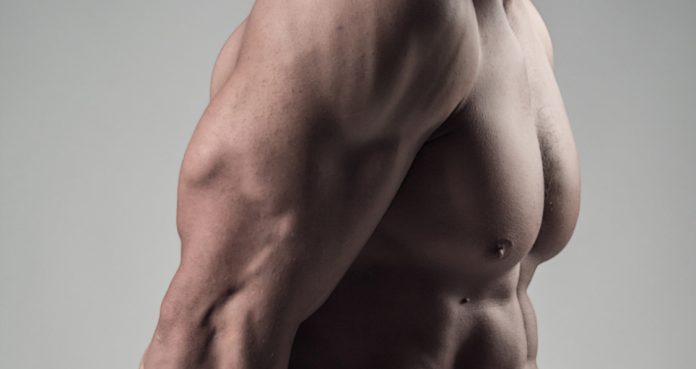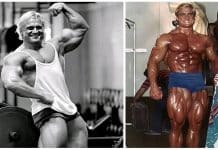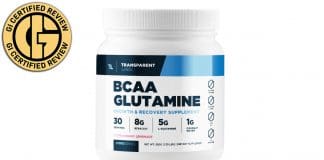
The Ultimate Exercise for Tricep Building
Regardless of whether you are a powerlifter, bodybuilder or sports athlete, you should be performing some form of tricep strengthening exercise in your training program.
Developing the triceps can have a positive impact on both strength, aesthetics and technique. However, despite this, many still fail to perform tricep work regularly enough.
If you are looking to improve your pressing and lockout ability for exercises such as bench, dips, handstands, snatch, and jerk, then there is a great need for strong triceps.
This article will review one of the best tricep strengthening exercises that you should be doing – the tricep skull crusher.
Not only will it breakdown skull crusher technique and explain a number of the benefits associated with the exercise, but it will also provide a selection of variations and alternatives.
Skull Crusher Technique and Muscles Worked
The skull crusher is an isolation exercise that specifically works the triceps. Isolation exercises involve moving through only one joint – in this case, the elbow joint.
Although other tricep-orientated exercises, such as the close grip bench press and dips, effectively work the triceps, there are other muscles that assist in these exercises as movement occurs through multiple joints.
Both single and multi-joint exercises have been found to be effective for building strength and size (1).
The benefit of the single-joint component of the skull crusher forces the triceps to do all the work which means they receive a large training stimulus and consequently adapt greatly.
Along with the triceps, an array of shoulder stabilizing muscles must activate in order to maintain stability in the shoulder joint.
These muscles do not change in length through a concentric or eccentric contraction, they contract isometrically which means the muscles are contracted however do not change in length.
This isometric contraction, primarily of the rear delts and scapular stabilizers, holds the upper arm in place. This then allows for deep elbow flexion and to place the demand on the triceps.
Detailed below you will find a step by step guide that will allow you to perform the perfect skull crusher.
Step 1
Set up a flat bench and grab a barbell using a shoulder-width grip. Lie back on the bench and press the bar up so that it sits directly over the top of the chest. The arms should be fully extended.
Grip width can be adjusted if necessary to find a grip that suits you best. The key point to ensure that the muscles of the upper back and around the shoulder blades can engage to stabilize the shoulder joint.
Step 2
From this position, keeping the upper arms fixed, bend at the elbows so that the barbell drops down towards the head.
As the barbell lowers, ensure that the elbows are tucked in tightly and do not allow them to flare out. Concentrate on squeezing the bar and keep the upper back muscles engaged throughout this phase.
Step 3
Once the barbell is directly above the cranium with the elbows in deep flexion, let the upper arm move backwards slightly.
Doing this will increase the stretch on the triceps while simultaneously maintaining tension on the muscle at the bottom of the movement.
Step 4
From there, pull the upper arms back to their original position and powerfully extend at the elbow to bring the arms out of deep flexion and return to the straight arm starting position.
Be wary of bringing the elbows too far forward during this step as this will reduce tricep isolation and potentially increase the strain placed on the shoulder.
4 Benefits Associated With Skull Crushers
Most athletes and lifters will benefit from performing skull crushers in one way or another. Listed below you will find 4 of greatest benefits associated with the skull crusher.
1) Increasing Tricep Strength
The most evident benefit of all is the fact that the exercise strengthens the tricep muscles. Having strong triceps will be beneficial for all pressing exercises and for improving shoulder stability.
For the powerlifter, having strong triceps is essential during the bench press. Considering that the triceps control elbow extension (2) they are particularly important during the lock-out.
In Olympic Lifting, having strong triceps will facilitate a more efficient catch in the jerk and the snatch and improve overhead stability.
More generally, improving tricep strength will have a positive impact on elbow joint health.
2) More Efficient lockouts
As stated, the triceps are most responsible for locking out the elbow joint. Having a strong lockout will facilitate a better bench, jerk and snatch.
By focusing on building tricep strength and size, most athletes and lifters will improve their lockout and therefore improve their overall performance.
3) Elbow Joint Health
Appropriate strength training can improve the health of many joints throughout the body and has been found to be useful for improving bone and joint conditions (3).
Providing that volume, intensity and technique is in place, the muscles will adapt to become more efficient at dealing with forces and stress.
This will take a lot of the strain of the connective tissues that surround the joints – ligaments, tendons and cartilage.
Therefore, increasing tricep strength can help to reduce the risk of elbow injury – specifically overuse injuries.
4) Increased Tricep Size
For a number of athletes, improving muscle size is a priority. For those looking to increase arm size, it is important to heavily target the triceps.
When building mass in the arms, most individuals focus too heavily on the biceps. In actuality, the main focus should be on tricep development as the triceps take up two-thirds of the upper arm.
Therefore, increasing the size of the triceps will cause the arms to look much bigger and fuller.
Skull Crusher Variations and Alternatives
In this section, you will find 3 variations and 3 alternatives to allow you to best progress or regress your training where appropriate.
Dumbbell Skull Crushers
One of the more simple changes that can be made to the skull crusher is to use dumbbells instead of a barbell or EZ bar.
The movement required is absolutely identical however using dumbbells forces the arms to work individually. This is particularly useful for any lifter who struggles with strength imbalances or stability issues (4).
Another benefit of the dumbbell variation is that it may allow for a greater range of motion and therefore place even more stress on the triceps.
Incline Bench Skull Crushers
As the name suggests, this variation involves setting a bench on a slight incline before performing the skull crusher. Feel free to use barbells or dumbbells for this variation.
The incline will cause a greater tricep stretch and allow you to target the tricep from a different angle. Both of these can facilitate an improvement in tricep strength and size.
Skull Crusher Negatives
Negatives involve focusing on the eccentric (lowering) phase of the movement. This advanced training method has been found to increase muscle damage and boost hypertrophy (5).
To maximize the eccentric phase of the skull crusher, very slowly lower the bar for a period of 3-5 seconds until it is directly over the head.
Consider using a spotter for safety and also to allow you to maximally work the triceps.
Close Grip Bench Press
The first alternative to target the triceps is a bench press variation. Assuming a close grip on the barbell during a bench press will predominantly recruit the triceps and pecs (chest).
In order to maximize triceps activation, look to tuck the elbows in tightly to the ribcage as the barbell is lowered to the chest.
The close grip bench press is not only great for tricep development but it will also facilitate a better lockout and is the perfect bench alternative for those with shoulder issues.
Dips
Full dips performed on bars or rings are a superb mass building exercise for the chest, shoulders, and arms.
For those who are new to dips, bodyweight will more than suffice to start with. For those who are more advanced, look to use additional resistance through the use of a dipping belt.
Remember, when it comes to strength training, you must always aspire to gradually make things more challenging if you want to continually improve in strength and size
Overhead Tricep Extensions
The final alternative is probably the most similar to the skull crusher in terms of movement. This exercise can be completed using barbells, dumbbells or cables.
The benefit of the overhead tricep extension in comparison to the skull crusher is that it may be less taxing on the elbow joint which is specifically important for those with elbow issues.
As the name suggests, the exercise involves holding the load overhead with straight arms. From that position, the elbows flex to drop the weight down before driving back up to the starting position.
Final Word
In comparison to other tricep focused exercises, the skull crusher reigns supreme. Not only will it effectively increase tricep strength and size but it may also facilitate performance with other lifts.
Therefore, the skull crusher, with its many variations and alternatives, should be seriously considered when designing a strength training program.
For more news and updates, follow Generation Iron on Facebook, Twitter, and Instagram.
References:
1-Gentil, Paulo; Soares, Saulo; Bottaro, Martim (2015-6). “Single vs. Multi-Joint Resistance Exercises: Effects on Muscle Strength and Hypertrophy”. Asian Journal of Sports Medicine. 6 (2). doi:10.5812/asjsm.24057. ISSN 2008-000X. PMC 4592763. PMID 26446291.
2-Landin, Dennis; Thompson, Melissa; Jackson, Meghan (2018-4). “Functions of the Triceps Brachii in Humans: A Review”. Journal of Clinical Medicine Research. 10 (4): 290–293. doi:10.14740/jocmr3340w. ISSN 1918-3003. PMC 5827912. PMID 29511416.
3-Westcott, Wayne L. (2012-7). “Resistance training is medicine: effects of strength training on health”. Current Sports Medicine Reports. 11 (4): 209–216. doi:10.1249/JSR.0b013e31825dabb8. ISSN 1537-8918. PMID 22777332.
4-Saeterbakken, Atle H.; van den Tillaar, Roland; Fimland, Marius S. (2011-3). “A comparison of muscle activity and 1-RM strength of three chest-press exercises with different stability requirements”. Journal of Sports Sciences. 29 (5): 533–538. doi:10.1080/02640414.2010.543916. ISSN 1466-447X. PMID 21225489.
5-Vogt, Michael; Hoppeler, Hans H. (June 1, 2014). “Eccentric exercise: mechanisms and effects when used as training regime or training adjunct”. Journal of Applied Physiology (Bethesda, Md.: 1985). 116 (11): 1446–1454. doi:10.1152/japplphysiol.00146.2013. ISSN 1522-1601. PMID 24505103.

















